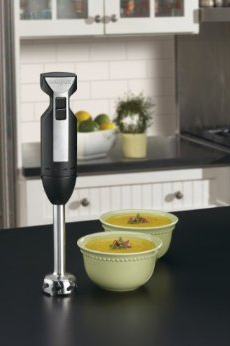TIP OF THE DAY: Immersion Blender Uses To Save Time & Effort
|
An immersion blender can take the place |
We own a food processor, stand mixer, hand-held beater, upright blender and immersion blender. We gave away our mother’s 1970s-era hand-cranked egg beater* a month ago. We may have used it for scrambled eggs decades ago, until we realized that the hand-held beater was easier to use and clean.
More recently, we replaced the hand-held beater with an immersion blender, our current favorite for many kitchen tasks. It’s compact, easy to store and transport (e.g., to make whipped cream for the dessert you’ve brought to a party) and easy to clean. The immersion blender was created by a Swiss inventor, Roger Perrinjaquet, who patented it in 1950. It was first used by professional chefs in Europe and was then discovered by chefs worldwide. A home version arrived in the U.S. in the 1980s. Chefs could easily blend sauces and soups in the pot, without having to transfer the hot contents to an upright blender. We got an IB a year or two ago, after watching chefs use them on cooking shows. Did we really need another special-use kitchen appliance? No, but the IB does make life easier. |
|
|
You can use it to blend just about anything in a pot or bowl. It’s a multi-tasker that’s good for smaller tasks and easy to transport. You can buy one for under $30, or chose a deluxe model with wire whisk and chopper attachments (as we did). The deluxe models typically have twice the motor power and more speed options. While our original intent was to blend soup, we found that our immersion blender could also gracefully take the place of a food processor, upright blender or handheld beater for many tasks. In alphabetical order, they are: While there are numerous products on the market, here are two representing the basic and deluxe models:
|
||



